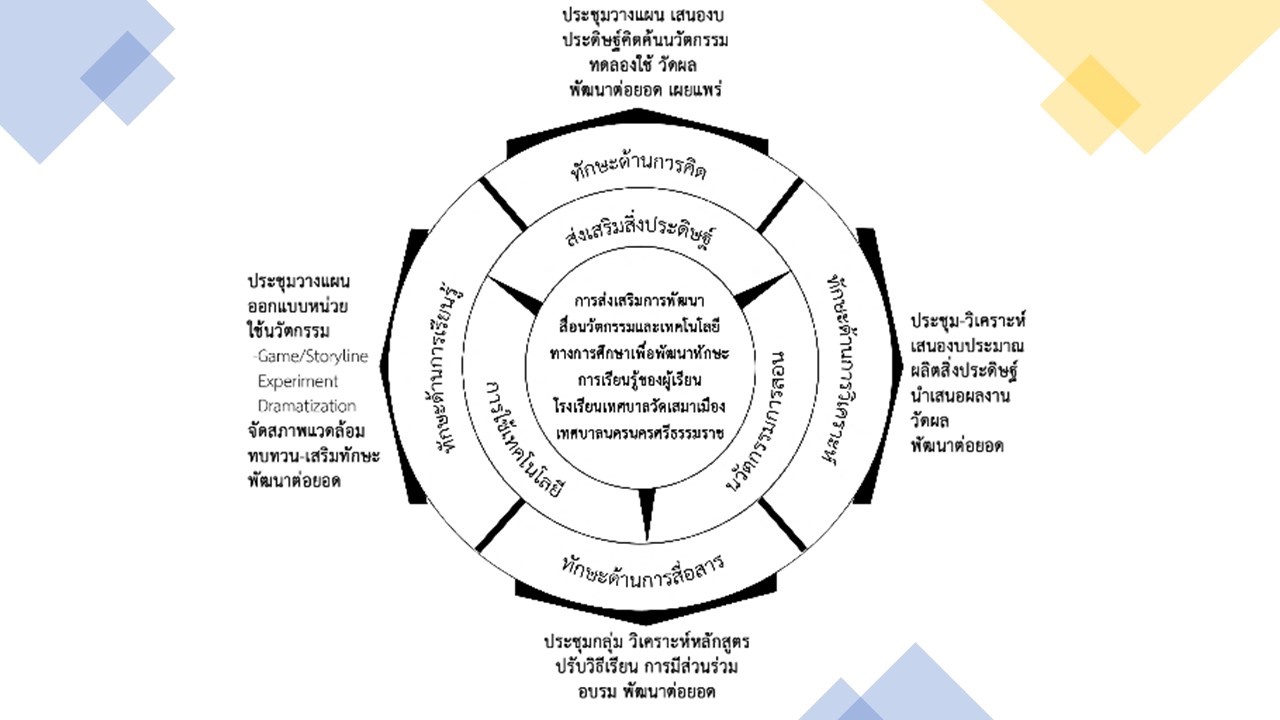การส่งเสริมการพัฒนาสื่อ นวัตกรรมและเทคโนโลยีทางการศึกษาเพื่อพัฒนาทักษะการเรียนรู้ของผู้เรียนโรงเรียนเทศบาลวัดเสมาเมืองเทศบาลนครนครศรีธรรมราช
Main Article Content
บทคัดย่อ
บทความวิจัยในครั้งนี้มีวัตถุประสงค์เพื่อ 1) ศึกษาสภาพการใช้สื่อ นวัตกรรม และเทคโนโลยีทางการศึกษาโรงเรียนเทศบาลวัดเสมาเมือง 2) ศึกษาแนวทางการส่งเสริมการพัฒนาสื่อนวัตกรรมและเทคโนโลยีทางการศึกษาเพื่อพัฒนาทักษะการเรียนรู้ของผู้เรียน โรงเรียนเทศบาลวัดเสมาเมือง และ3) นำเสนอแนวทางการส่งเสริมการพัฒนาสื่อนวัตกรรมและเทคโนโลยีทางการศึกษา เพื่อพัฒนาทักษะการเรียนรู้ของผู้เรียน โรงเรียนเทศบาลวัดเสมาเมือง เป็นการวิจัยเชิงคุณภาพมีผู้ให้ข้อมูลสำคัญโดยการสัมภาษณ์เชิงลึกจากผู้มีส่วนเกี่ยวข้อง 15 คน ผู้เชี่ยวชาญ 5 คน และสนทนากลุ่มผู้ทรงคุณวุฒิ 7 คน เครื่องมือที่ใช้เป็นแบบสัมภาษณ์เชิงลึก และการสนทนากลุ่ม วิเคราะห์ข้อมูลด้วยวิธีการวิเคราะห์เนื้อหา ผลการวิจัย พบว่า 1) สภาพการใช้สื่อสิ่งประดิษฐ์โรงเรียนเทศบาลวัดเสมาเมือง ยังล้าสมัย การผลิตสื่อสิ่งประดิษฐ์ไม่สอดคล้องกับยุคปัจจุบัน สภาพการใช้เทคโนโลยีคอมพิวเตอร์โปรแกรมบางส่วน ยังล้าสมัย เครือข่ายอินเทอร์เน็ตไม่เสถียร สภาพการใช้นวัตกรรมการสอนขาดเครื่องมือในการผลิตนวัตกรรมการสอนที่ทันสมัย 2) แนวทางการส่งเสริมการพัฒนาสื่อ นวัตกรรมและเทคโนโลยีทางการศึกษาเพื่อพัฒนาทักษะการเรียนรู้ของผู้เรียน ด้านที่ 1 การใช้สิ่งประดิษฐ์พัฒนาทักษะด้าน การคิด การวิเคราะห์การสื่อสารและการเรียนรู้ของผู้เรียนได้ ด้านที่ 2 การใช้เทคโนโลยีพัฒนาทักษะด้านการคิดการวิเคราะห์ การสื่อสาร การเรียนรู้ของผู้เรียนได้ ด้านที่ 3 นวัตกรรมการสอนพัฒนาทักษะการเรียนรู้ด้านการคิด การวิเคราะห์ การสื่อสารและทักษะการเรียนรู้ของผู้เรียนได้ 3) ผลการนำเสนอแนวทางการส่งเสริมการพัฒนาสื่อ นวัตกรรมและเทคโนโลยีทางการศึกษาเพื่อพัฒนาทักษะการเรียนรู้ของผู้เรียน มีความเป็นไปได้ เหมาะสมและเป็นประโยชน์ ข้อเสนอแนะจากผู้ทรงคุณวุฒิการสนทนากลุ่ม การนำสื่อสิ่งประดิษฐ์ นวัตกรรมการสอนและเทคโนโลยีทางการศึกษาเป็นแนวทางที่สามารถนำไปใช้ได้จริงในการพัฒนาทักษะการเรียนรู้ของผู้เรียนเป็นต้นแบบได้
Article Details
เอกสารอ้างอิง
กระทรวงศึกษาธิการ. (2560). แผนการศึกษาแห่งชาติ พ.ศ. 2560 – 2579. กรุงเทพฯ: พริกหวานกราฟฟิค. https://www.stou.ac.th/Offices/Oaa/Dept/Dept04/Rule_MUA/Plan_Inter2560-2579.pdf
กระทรวงศึกษาธิการ. (2566). นโยบายการศึกษาและแนวทางการขับเคลื่อนนโยบาย “เรียนดี มีความสุข”. https://otepc.go.th/th/content_page/item/4606-2023-09-14-06-26-05.html
กิดานันท์ มะลิทอง. (2543). เทคโนโลยีการศึกษาและนวัตกรรม. พิมพ์ครั้งที่ 2. กรุงเทพฯ: สำนักพิมพ์แห่งจุฬาลงกรณ์มหาวิทยาลัย.
ชวลิต เข่งทอง. (2558). สื่อการเรียนการสอน. กรุงเทพฯ: มหาวิทยาลัยเทคโนโลยีพระจอมเกล้าพระนครเหนือ.
ชัยยงค์ พรหมวงศ์. (2560). ชุดวิชาเทคโนโลยีและสื่อสารการศึกษา, หน่วยที่ 1 สามัญทัศน์เทคโนโลยีและสื่อสารการศึกษา. https://kku.world/y1wcm
ธันยรัตน์ เสริมเสนาพร. (2563). ความต้องการพัฒนาทักษะการเรียนรู้ในศตวรรษที่ 21 ของนักศึกษาเมียนมาร์ ศูนย์การศึกษานอกระบบโรงเรียนและการศึกษาตามอัธยาศัย จังหวัดสมุทรสาคร. วิทยานิพนธ์ศึกษาศาสตรมหาบัณฑิต สาขาวิชาการศึกษาตลอดชีวิตและการพัฒนามนุษย์. บัณฑิตวิทยาลัย: มหาวิทยาลัยศิลปากร.
บุญเกื้อ ควรหาเวช. (2543). นวัตกรรมการศึกษา. กรุงเทพฯ: ภาควิชาเทคโนโลยีการศึกษา คณะศึกษาศาสตร์ มหาวิทยาลัยศรีนครินทรวิโรฒ.
ปุณภพ ปรมาธิกุล. (2562). การพัฒนาทักษะการเรียนรู้และนวัตกรรมโดยใช้การจัดการเรียนรุ้เชิงบูรณาการสเต็มศึกษาแบบเทคโนโลยีหุ่นยนต์สำหรับนักเรียนชั้นประถมศึกษาตอนปลาย. วิทยานิพนธ์ศึกษาศาสตรมหาบัณฑิต สาขาหลักสูตรและการสอน มหาวิทยาลัยธุรกิจบัณฑิต.
พิชญะ กันธิยะ. (2559). การพัฒนาทักษะการคิดวิเคราะห์โดยใช้การจัดการเรียนรู้แบบบันได 5 ขั้นวิชาวิทยาศาสตร์ ของนักเรียนชั้นมัธยมศึกษาตอนต้น. วิทยานิพนธ์หลักสูตรครุศาสตรมหาบัณฑิต สาขาวิชาหลักสูตรและการสอน มหาวิทยาลัยราชภัฏเชียงใหม่
ราชกิจจานุเบกษา. (2562). พระราชบัญญัติการศึกษาแห่งชาติ พ.ศ. 2542 และที่แก้ไขเพิ่มเติม ฉบับที่ 2 พ.ศ. 2545, ฉบับที่ 3 พ.ศ. 2553 และฉบับที่ 4 พ.ศ. 2562. https://kku.world/wh1b8
วิชัย วงษ์ใหญ่ และมารุต พัฒผล. (2565). ทักษะการเรียนรู้และพัฒนา (Learning and Development Skills).กรุงเทพฯ: ศูนย์ผู้นำนวัตกรรมหลักสูตรและการเรียนรู้ มหาวิทยาลัยศรีนครินทรวิโรฒ
ศรุติ อัศวเรืองสุข. (2559). นวัตกรรม เทคโนโลยีและการสื่อสารทางการศึกษา. อุดรธานี: มหาวิทยาลัยราชภัฏอุดรธานี.
ศศิมา สุขสว่าง. (2567). การพัฒนานวัตกรรมโดยใช้ Design Thinking. https://kku.world/tlxbr
ศุภลักษณ์ ทองจีน. (2558). การออกแบบและการจัดการเรียนรู้. อุดรธานี: มหาวิทยาลัยราชภัฎอุดรธานี.
สุดารัตน์ ศรีมา. (2565). นวัตกรรมทางเทคโนโลยีดิจิทัลเพื่อการศึกษา. กรุงเทพฯ: มหาวิทยาลัยราชภัฏสวนสุนันทา.
อนุศักดิ์ สมิตสันต์. (2550). การจัดและการบริหารงานวิชาการ. กรุงเทพฯ: สำนักพิมพ์มหาวิทยาลัยรามคำแหง.
อาภา วรรณฉวี. (2565). การคิดวิเคราะห์. https://kku.world/poyk8
Aladwan,S.S.E. (2020). The use of Educational Technologies and ModernElectronic Educational Media in Teaching Science Subject to Grades (fourth, fifth and sixth) and Their Impact on the Educational Process from the Viewpoint of Teachers of Government Schools Affiliated with the Jordanian Ministry of Education. Jordan, 2020 Ilkogretim Online -Elementary Education Online, p. 1254-1267.
Bloom. B.S. (1956). Taxonomy of Educational Objectives, the classification of Educational Goals – Handbook I: Cognitive Domain. New York: McKay.
Butyrina, M. and Hyrina, T. (2019). The Development of Innovative Media Education Styles in the Era of Information and Communication Technologies. University of the State Fiscal Service of Ukraine, 31, University Street, Irpin, 08201, Ukraine.
Cholifah, P.S., and Others. (2020). Training on Development of Edutainment-Based Innovative Learning Media for Teacher Professional Development. Universitas Negeri Malang, Malang, Indonesia, p. 190-193.
Dale, E. (1969). Audio-Visual Method in Teaching. New York: Dryden Press.
James, D. F. (1972). Extending Education Through Technology; Selected Writings on Instructional Technology. Association for Educational Communications & Technology.
Tety, J.L. (2016). Role of Instructional Materials in Academic Performance in Community Secondary Schools in Rombo District. A Dissertation Submitted in Partial Fulfilment of the Requirements for the Degree of Master of Education in Administration. Planning and Policy Studies of the Open University of Tanzania.


